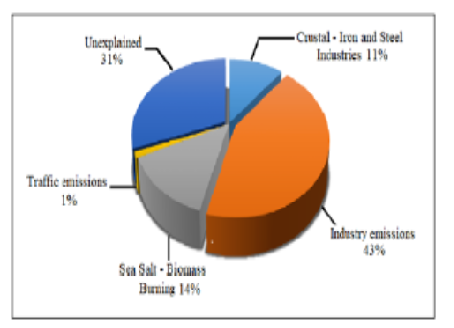


Indian Journal of Science and Technology
Year: 2024, Volume: 17, Issue: 9, Pages: 780-786
Original Article
Alassane Traore1*, Moustapha Kebe2, Malick Sow1, Vasiliki Vasilatou3, Ababacar Sadikhe Ndao1,2
1Departement de Physique, Faculté des Sciences et Techniques, Université Cheikh Anta Diop, Dakar, Senegal
2Institut de Technologie Nucléaire Appliquée, Université Cheikh Anta Diop, Dakar, Senegal
3E.R.L., Institute of Nuclear & Radiological Sciences & Technology, Energy & Safety, N.C.S.R. Demokritos, 15310, Ag. Paraskevi, Attiki, Greece
*Corresponding Author
Email: [email protected]
Received Date:22 November 2023, Accepted Date:26 January 2024, Published Date:20 February 2024
b Source apportionment of PM2.5-10 and PM2.5 was conducted using two receptor models: the principal component analysis/absolute principal component scores (PCA/APCS) and the positive matrix factorization (PMF). Methods: The PCA/APCS model resolved four sources, namely, mineral dust, sea salt/secondary sulfur, a mixed source, and traffic and industry emissions. PMF model also resolved four sources of the same origin based on the proportion of each component from the analysis. All models identified the main sources that contribute to PM2.5-10 and PM2.5 emissions and reconfirmed that the potential sources were the dominants in particulate matter in the Capital city. Findings: The first four extracted component accounted for nearly 88.3% of the variability of the data set. The running matrix elements used for data processing within collected air particulate matter was BC, Na, Al, Si, P, S, Cl, K, Ca, Ti, V, Cr, Mn, Fe, Ni, Cu, Zn, Br, Rb, Sr, Ba, and Pb. This discrimination of the area of Dakar cites according to the PCA/APCS results confirms the impact that the major activities have on the environment in the most appropriate way, and it verifies the results of previous studies about the influence of Industry emissions, mineral dust, traffic emissions and sea salt/secondary sulfur on the surrounding urban areas. Novelty: Continued collection of speciation data at the urban areas will enhance the understanding of local versus regional source contributions for air quality index in sub-Sahara region.
Keywords: Aerosol, Particulate Matter, Source apportionment, receptor Modelling, XRF, heavy metals
© 2024 Traore et al. This is an open-access article distributed under the terms of the Creative Commons Attribution License, which permits unrestricted use, distribution, and reproduction in any medium, provided the original author and source are credited. Published By Indian Society for Education and Environment (iSee)
Subscribe now for latest articles and news.